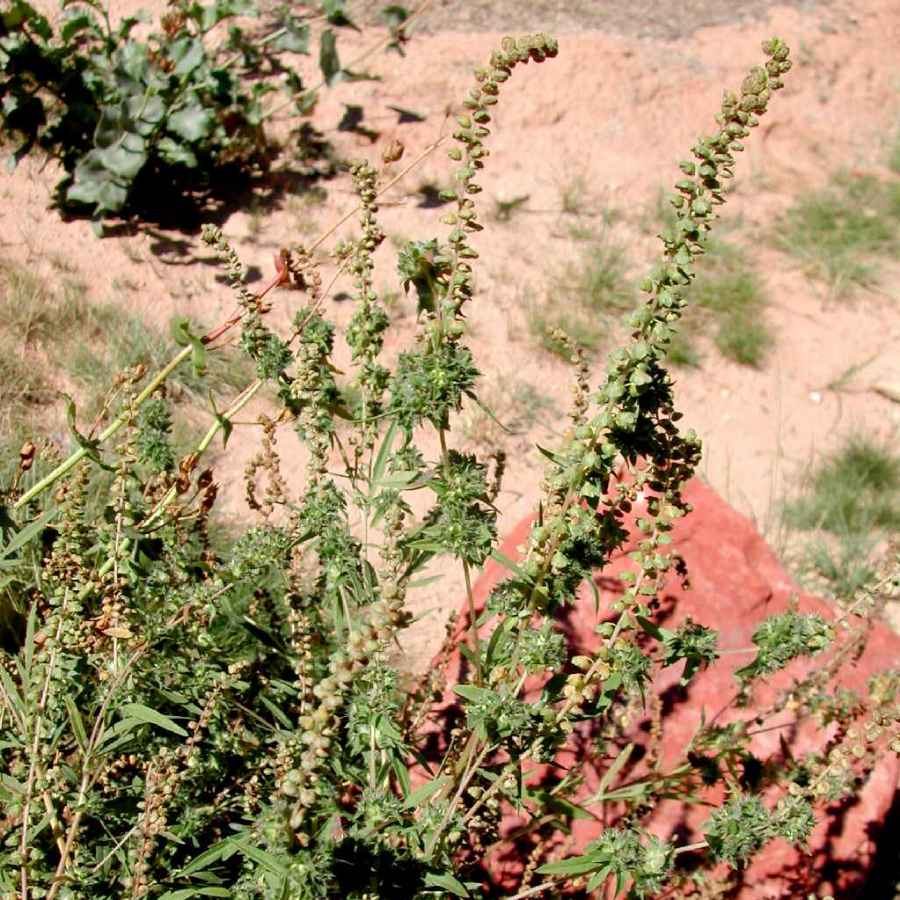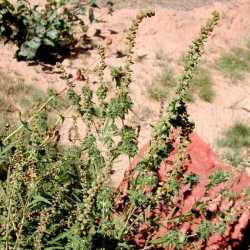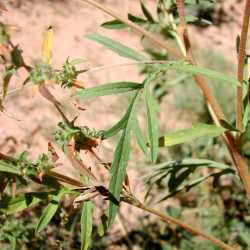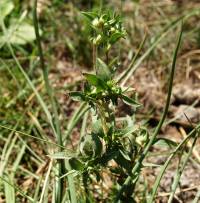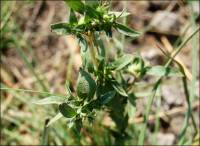Annuals, 10-60(-150+) cm. Stems erect. Leaves opposite (proximal) and alternate; petioles 25-35(-60+) mm; blades deltate to lanceolate or elliptic, 25-55(-90+) × 20-30(-50+) mm, 1-2-pinnately lobed, bases cuneate, ultimate margins entire or toothed, abaxial faces sparsely pilosulous to strigillose, adaxial faces strigillose, both gland-dotted. Pistillate heads clustered, proximal to staminates; florets 1. Staminate heads: peduncles 0.5-1.5 mm; involucres shallowly cup-shaped (usually without black nerves), 2-3+ mm diam., glabrous or hispid to pilosulous; florets 12-20+. Burs: bodies ± globose to pyriform, 2-3 mm, ± pilosulous, spines or tubercles 3-5+, near middles or distal, ± conic to acerose, 0.1-0.5+ mm, tips straight. 2n = 34, 36.
Flowering Jul-Oct. Wet to dry soils, disturbed sites; 0-1000+ m; Alta., B.C., Man., N.B., Nfld. and Labr. (Nfld.), N.W.T., N.S., Ont., P.E.I., Que., Sask.; Ala., Alaska, Ariz., Ark., Calif., Colo., Conn., Del., D.C., Fla., Ga., Idaho, Ill., Ind., Iowa, Kans., Ky., La., Maine, Md., Mass., Mich., Minn., Miss., Mo., Mont., Nebr., Nev., N.H., N.J., N.Mex., N.Y., N.C., N.Dak., Ohio, Okla., Oreg., Pa., R.I., S.C., S.Dak., Tenn., Tex., Utah, Vt., Va., Wash., W.Va., Wis., Wyo.
Hybrids between Ambrosia artemisiifolia and A. psilostachya have been called A. ×intergradiens W. H. Wagner. The name Ambrosia ×helenae Rouleau applies to hybrids between A. artemisiifolia and A. trifida.
I am referring all of our reports under whatever name reported to this species. As Jones has pointed out, it is a highly variable plant, producing pistillate plants and also plants bearing both stamens and pistils. An abundant weed everywhere in cultivated and fallow fields, waste places, roadsides, and almost any place where the ground is not covered with a sod of grass. Milch cows are usually kept out of pastures and stubble fields where it is abundant because when they eat this plant the milk has a nauseating taste. The ragweeds are a few of the species whose pollen causes autumnal hay fever. On account of the abundance of these plants they have the credit of being the chief cause of this disease.
Indiana Coefficient of Conservatism: C = 0
Wetland Indicator Status: FACU
Duration: Annual
Nativity: Native
Lifeform: Forb/Herb
General: Annual herb that is variously pubescent; mostly branching above but sometimes below; 10-100 cm tall.
Leaves: Opposite below and alternate above; middle and lower leaves on petioles 2.5 cm or longer; blades once or twice pinnatifid, 3-10 cm long, strigillose and gland dotted.
Flowers: Pistillate and staminate flowers in separate heads; all heads discoid; staminate heads nodding in terminal racemes, 3-5 mm wide; involucre 2-3 mm high, cup-shaped, scarcely lobed and with coarse hairs, with 12-20+ florets; pistillate heads 3-5 mm long, 1-flowered, sessile in leafy axillary clusters.
Fruits: Burs globose to pyriform, 2-3 mm, with a single whorl of 3-5 spines, those 1 mm long.
Ecology: Found on roadsides, in old fields, and other waste places; weedy but not common; from 5,000-8,000 ft (1524-2438 m); flowers August-September.
Distribution: Throughout N. Amer.; introduced to Europe.
Notes: This species is probably native to the eastern US and is not particularly common in the Southwest. It is quite similar to A. acanthicarpa, the other annual Ambrosia in this region, which is much more common. A. acanthicarpa has larger burs 4-8 mm long with 6-30 flattened spines in 2 series, and the staminate involucres have black nerves (A. artemisiifolia lacks these). A. psilostachya and A. confertiflora are also similar, but both those species are perennial. A. artemisiifolia is a host plant for Bordered Patch butterfly.
Ethnobotany: Used externally to treat skin problems including insect stings, hives, infected toes, and scalp diseases; infusion of leaf taken for fever, pneumonia, vomiting, bloody flux, and stroke; decoction of root taken for menstrual troubles; plant also used for toilet paper.
Etymology: Ambrosia is Greek for food of the gods, while artimisiifolia means having leaves that resemble Artemisia.
Synonyms: Ambrosia artemisiifolia var. elatior, Ambrosia elatior
Editor: SBuckley 2010, AHazelton 2015
Annual weed 3-10 dm, branching at least above, variously hairy or in part subglabrous; lvs opposite below, alternate above, once or more often twice pinnatifid, the blade narrowly to broadly ovate or elliptic in outline, 4-10 cm, the middle and lower ones, at least, evidently petiolate; staminate invols short-pedunculate, symmetrical or slightly oblique, inconspicuously nerved; fruiting invols 3-5 mm, 1-fld and 1 beaked, with a single series of short, sharp, erect spines near or above the middle; 2n=34, 36. Waste places; throughout our range, w. to the Pacific. (July) Aug.-Oct. (A. elatior; A. media)
Gleason, Henry A. & Cronquist, Arthur J. 1991. Manual of vascular plants of northeastern United States and adjacent Canada. lxxv + 910 pp.
©The New York Botanical Garden. All rights reserved. Used by permission.


